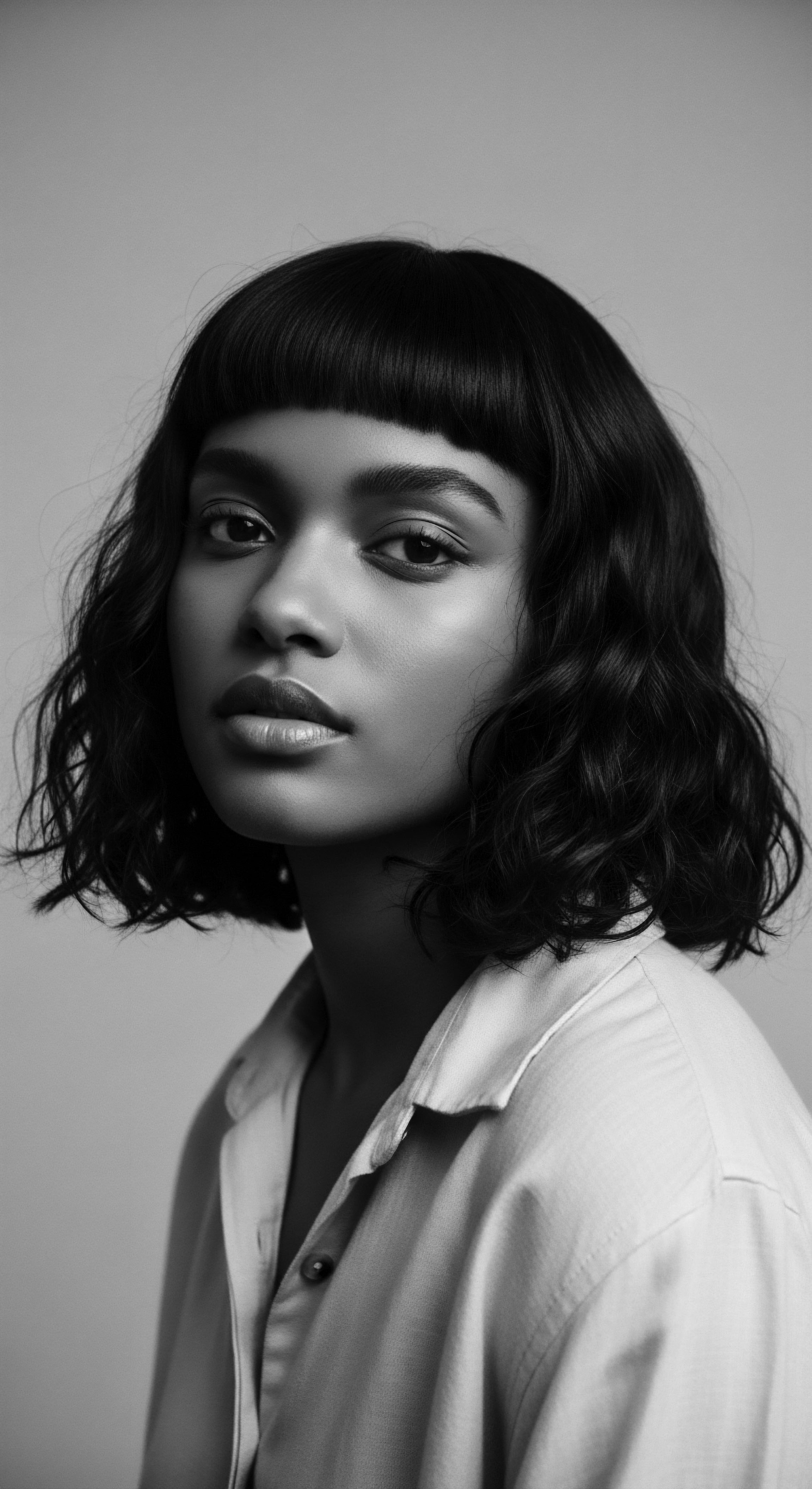
Fundamentals
Within Roothea’s expanding lexicon, Covert Communication signifies the profound, often unspoken, dialogue embedded within textured hair, its styles, and the rituals surrounding its care. This understanding moves beyond mere aesthetics, recognizing hair as a vibrant medium for transmitting meaning, memory, and cultural resilience across generations. It speaks to the silent declarations of identity and resistance, the ancestral whispers held within every coil, braid, and twist.
The very fibers of textured hair, with their unique structures and inherent properties, carry stories of survival, wisdom, and deep connection to lineage and community. This concept acknowledges hair as a living archive, constantly sharing truths about one’s origins, spirit, and bond with the earth and collective human experience.
The earliest manifestations of Covert Communication are rooted in the elemental biology of textured hair. The distinct patterns of coils and curls, the natural resilience of the strand, and its ability to retain moisture and shape were not simply biological traits. They were foundational elements that shaped ancestral practices, allowing for styles that could convey complex social, spiritual, and historical information.
The inherent qualities of the hair itself laid the groundwork for a language that could be seen, felt, and understood without uttering a single word. This primal connection to hair’s physical attributes informs our appreciation for its role in the silent narratives of humanity.
Covert Communication in textured hair is the silent language of lineage, etched into each strand, revealing histories of identity, resistance, and communal wisdom.
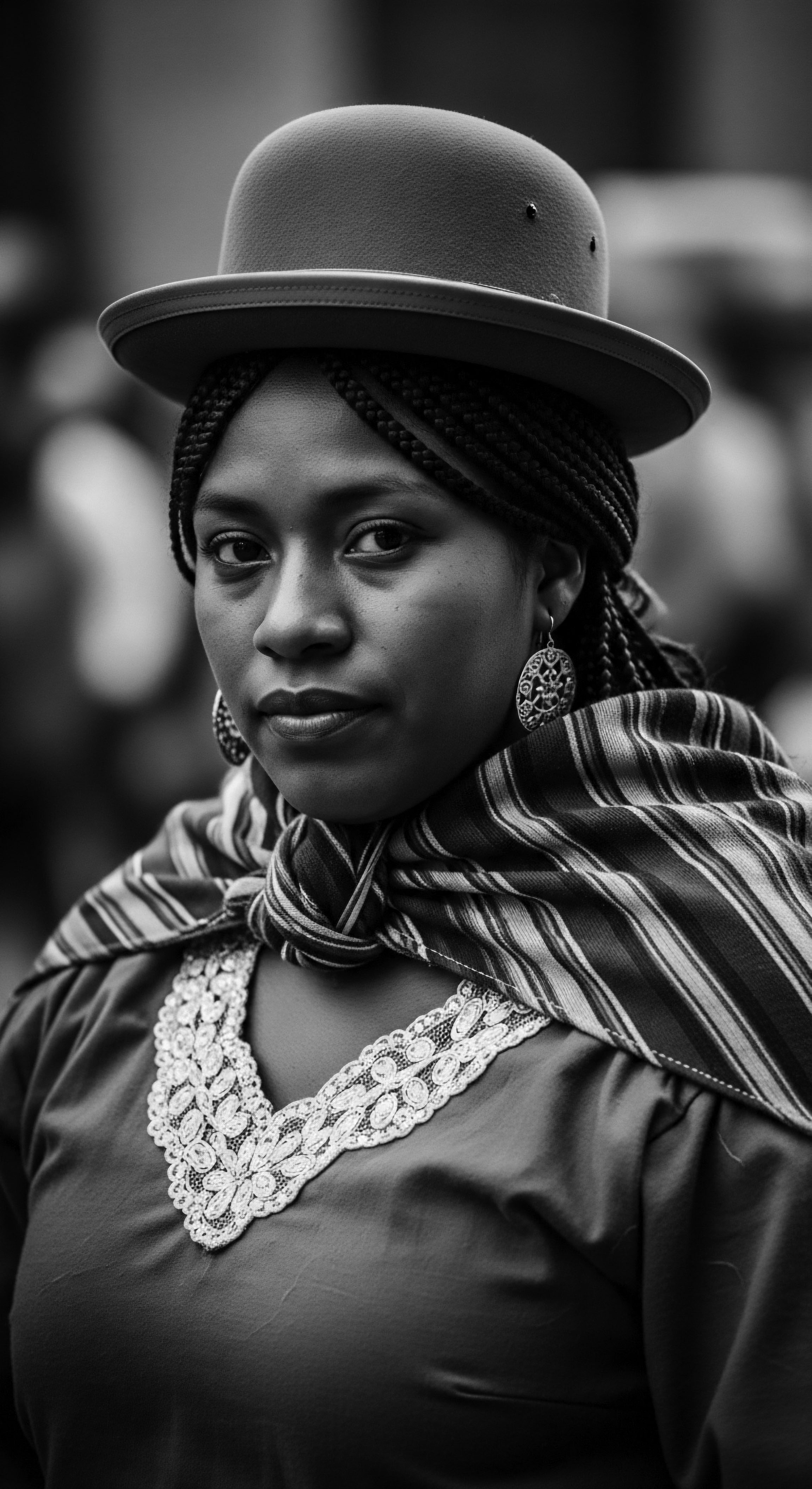
Echoes from the Source ❉ Hair as an Ancient Transmitter
Long before written languages became widespread, hair served as a primary conduit for non-verbal communication in many African societies. The appearance of one’s hair could immediately convey a wealth of information about an individual’s social standing, marital status, age, tribal affiliation, and even their religious beliefs. These intricate hairstyles were not simply decorative; they were living narratives, visually articulating a person’s place within their community and the world around them. This deep societal embedding of hair practices meant that understanding the subtle cues in a hairstyle was akin to understanding a local dialect.
For instance, in Yoruba culture, skilled braiders, highly respected within society, crafted hairstyles that carried deep spiritual significance. Styles like the “Irun Kiko,” a form of thread-wrapping, were not only visually striking but also conveyed meanings related to femininity, marriage, and coming-of-age rites. Braids could indicate a woman’s marital status, fertility, or her rank within the community.
Young women often wore elaborate braids during initiation ceremonies, signifying their transition to adulthood. This historical context underscores how hair, even in its most basic styling, was saturated with layers of meaning, forming a rich and unspoken cultural vocabulary.
The ancestral understanding of hair also extended to its perceived spiritual properties. Many African traditions considered hair a sacred antenna, a direct link connecting individuals to spiritual realms, their higher selves, and the wisdom of their ancestors. The growth of hair was often seen as mirroring the deepening of spiritual connection.
Engaging in intentional hair care practices, therefore, was not merely about physical upkeep; it was a ritualistic act of tuning one’s energetic frequency, clearing energetic debris, and strengthening spiritual protection. This perspective reveals a profound holistic view where hair was not separate from the spiritual self, but an integral part of one’s energetic being.

The Unspoken Atlas ❉ Hair as a Guide
One of the most powerful examples of Covert Communication, particularly during periods of immense adversity, is the use of hair as a means of encoding vital information. During the transatlantic slave trade, when enslaved Africans were forcibly stripped of their cultural identities and denied the ability to read or write, hair became a secret language for survival. This period saw the transformation of traditional braiding into a tool for covert messaging.
In regions like Colombia, cornrow patterns were reportedly used to create maps and directions for escape routes. The specific patterns of the braids, their direction, and even the number of braids could indicate paths, rivers, or safe houses. This ingenious method allowed enslaved people to share critical information without drawing suspicion from their captors. The coarse texture of African hair was particularly suited for holding these intricate designs, making the hair itself a living, breathing map.
Beyond mapping escape routes, enslaved individuals also hid small, life-sustaining items within their braids. Grains of rice or seeds were braided into the hair, providing nourishment for long journeys to freedom. This act of concealing sustenance within hair speaks volumes about the ingenuity and resilience of a people determined to survive and reclaim their autonomy. The hair, therefore, became a silent repository of hope and a practical tool for liberation.
| Historical Context Pre-colonial African Societies |
| Method of Covert Communication Intricate styles, adornments, specific partings indicating social status, age, marital status, tribal affiliation. |
| Significance to Heritage Preservation of social order, identity, and cultural values within communities. |
| Historical Context Transatlantic Slave Trade |
| Method of Covert Communication Cornrow patterns as maps for escape routes, hiding seeds/gold within braids. |
| Significance to Heritage Survival, resistance against oppression, maintenance of cultural identity in hostile environments. |
| Historical Context Colonial Era / Civil Rights Movements |
| Method of Covert Communication Afro hairstyles as symbols of pride and defiance; tignons as acts of reclamation. |
| Significance to Heritage Assertion of Black identity, rejection of Eurocentric beauty standards, political statement of self-love and solidarity. |
| Historical Context These instances collectively underscore how hair, particularly textured hair, has consistently served as a powerful, non-verbal medium for expressing deep cultural truths and resisting systemic pressures throughout history. |
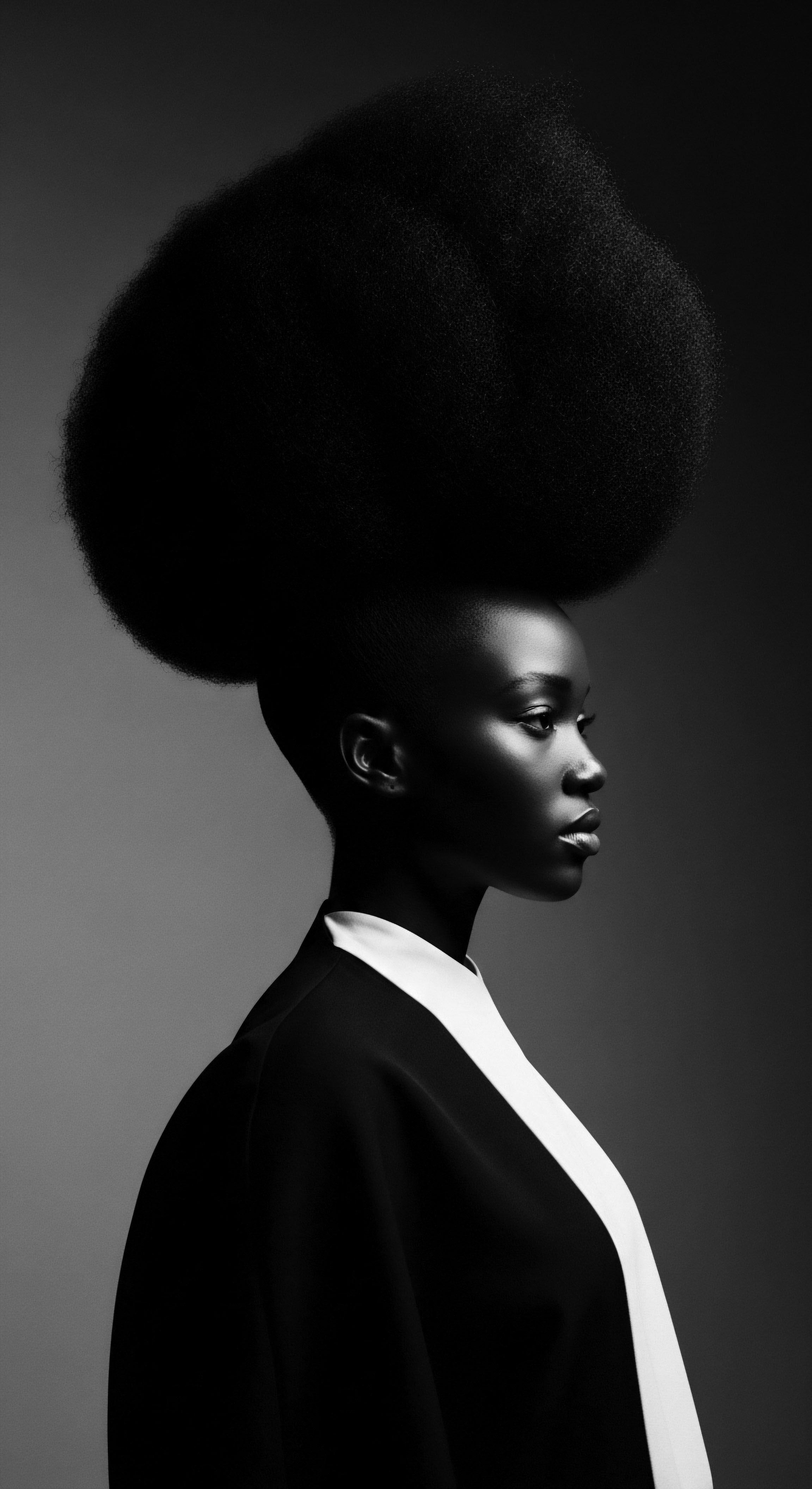
Intermediate
Expanding upon the foundational understanding, Covert Communication within textured hair encompasses a more nuanced recognition of its role in sustaining cultural identity and collective memory, particularly through the diaspora. It is not merely about transmitting overt messages, but also about the subtle ways hair practices become vessels for ancestral knowledge, emotional solace, and communal solidarity. This deeper meaning acknowledges the complex interplay between the biological realities of textured hair and the socio-historical contexts that have shaped its significance. Hair becomes a testament to the ingenuity of a people who found ways to communicate and thrive even when overt expression was suppressed.
The communal nature of hair care, prevalent across many African and diasporic communities, serves as a powerful, yet often unspoken, form of communication. These sessions, where hands move through hair, braiding, twisting, and tending, are far more than grooming rituals. They are spaces of intergenerational exchange, where stories are shared, wisdom is passed down, and bonds are strengthened.
The gentle touch, the shared laughter, the quiet moments of reflection – all contribute to a rich tapestry of non-verbal communication that reinforces cultural continuity and belonging. This tender thread of connection speaks volumes about the enduring spirit of community.
Hair care rituals are not just about grooming; they are communal acts of preserving memory, sharing wisdom, and strengthening the silent bonds of heritage.

The Tender Thread ❉ Sustaining Community and Identity
The practices of styling and caring for textured hair have historically been communal activities, especially among women. Gatherings for braiding, twisting, or oiling hair provided opportunities for sharing experiences, offering advice, and extending support. This act of hairstyling became a form of social solidarity, enabling community members to maintain unity, even in foreign or hostile environments.
For enslaved populations, these communal sessions were vital for maintaining morale, providing a space where cultural traditions could be preserved and transmitted in secret. Despite being separated from their families and tribes, the act of braiding allowed them to retain a sense of connection and shared identity.
Consider the significance of the Tignon laws in Louisiana during the late 18th century. These laws compelled Creole women of color to cover their hair with headscarves, known as tignons, in public. The intention behind these laws was to visually communicate their perceived lower social status and prevent them from appearing “too beautiful” or “too attractive” in the eyes of white society. However, in a powerful act of covert defiance, these women transformed the tignon into a symbol of their resilience and creativity.
They used luxurious fabrics, vibrant colors, and elaborate styles, turning an instrument of oppression into a statement of dignity and self-expression. This act demonstrated a profound understanding of Covert Communication, where a mandated restriction was subverted to convey a message of pride and autonomy.
- Hair as a Spiritual Conduit ❉ In many African cosmologies, hair was seen as a sacred extension of the spirit, connecting individuals to their ancestors and deities.
- Rituals of Care ❉ Traditional hair care practices often involved natural ingredients like shea butter, coconut oil, and aloe vera, reflecting an ancestral understanding of holistic wellness and the gifts of the earth.
- Communal Bonding ❉ Hair styling sessions served as vital social gatherings, fostering intergenerational learning and strengthening community ties through shared stories and rituals.

The Language of Adornment and Expression
Beyond the structural patterns, the adornment of textured hair also played a crucial role in Covert Communication. Beads, cowrie shells, precious metals, and other natural elements were not merely decorative additions; they carried specific meanings related to status, wealth, spiritual beliefs, and life events. The placement and type of adornment could signal a person’s readiness for marriage, their accomplishments, or their connection to particular spiritual traditions. This layered symbolism allowed for a visual dialogue that was rich in cultural context and accessible to those who understood its silent grammar.
For instance, the Himba people in Namibia traditionally used otjize, a paste of ochre, butterfat, and herbs, to coat their hair and skin. This practice, which gives their hair a distinctive reddish hue, symbolizes their connection to the earth and their ancestors. It communicates a deep reverence for tradition, a commitment to cultural identity, and a visual representation of their lineage. The choice of adornment, whether a specific type of bead or the deliberate application of natural pigments, becomes a silent yet powerful declaration of belonging and heritage.
The evolution of hairstyles within the African diaspora also serves as a powerful testament to Covert Communication. The emergence of the Afro during the Civil Rights and Black Power movements in the United States, for example, was a deliberate act of defiance against Eurocentric beauty standards. This style, which celebrated the natural texture and volume of Black hair, became a symbol of Black pride, self-acceptance, and a visual rejection of oppressive norms. It was a loud, unspoken statement of identity and solidarity, signaling a collective shift towards self-definition and liberation.
| Era 18th Century (Louisiana) |
| Hairstyle/Practice Tignons (headwraps) worn by free Creole women of color. |
| Covert Message Conveyed Defiance of oppressive laws, assertion of dignity, creativity, and self-expression despite forced subjugation. |
| Era 1960s-1970s (Civil Rights/Black Power) |
| Hairstyle/Practice Afro hairstyles. |
| Covert Message Conveyed Black pride, rejection of Eurocentric beauty standards, political solidarity, and self-acceptance. |
| Era Contemporary Era (Natural Hair Movement) |
| Hairstyle/Practice Embracing natural textures, diverse protective styles (locs, braids, twists). |
| Covert Message Conveyed Reclamation of heritage, celebration of unique beauty, holistic wellness, and ongoing resistance to hair discrimination. |
| Era The adaptation and re-contextualization of hair practices demonstrate a continuous, evolving dialogue through non-verbal means, reflecting the resilience and cultural dynamism of textured hair communities. |

Academic
The academic delineation of Covert Communication, within the rigorous framework of Roothea’s ‘living library,’ posits it as a complex semiotic system inherent in textured hair, functioning as a non-linguistic yet deeply meaningful channel for the transmission of socio-cultural data, historical memory, and embodied resistance. This conceptualization extends beyond mere symbolic representation, proposing that the unique biophysical properties of textured hair, coupled with culturally codified styling practices, create a robust, resilient medium for information exchange, particularly within marginalized communities where overt forms of communication were historically constrained. The meaning conveyed through this covert system is not arbitrary; it is meticulously constructed through generations of collective experience, ancestral wisdom, and the strategic adaptation of aesthetic forms to serve profound socio-political purposes. This perspective requires an interdisciplinary lens, drawing from anthropology, ethnobotany, communication studies, and the burgeoning field of hair science, all grounded in the lived experiences of Black and mixed-race communities.
A core tenet of this academic interpretation is the understanding that textured hair itself, prior to any human manipulation, carries an inherent biological narrative. The helical structure of coily and curly strands, their distinct protein arrangements, and their varied porosity levels are not simply physiological characteristics; they are the elemental alphabet of a deep, ancient language. This inherent variability within textured hair types, often categorized by systems like the Andre Walker hair typing chart, allows for a spectrum of styling possibilities that can be leveraged for specific communicative functions.
The scientific understanding of hair’s capacity for structural integrity and its response to environmental factors thus provides a biological underpinning for its historical role as a medium for covert messaging. The resilience of the hair strand, its ability to withstand manipulation and hold complex forms, mirrors the resilience of the communities it represents.
Covert Communication in textured hair is a meticulously constructed semiotic system, leveraging biophysical properties and cultural codes to transmit vital information and historical memory across generations.
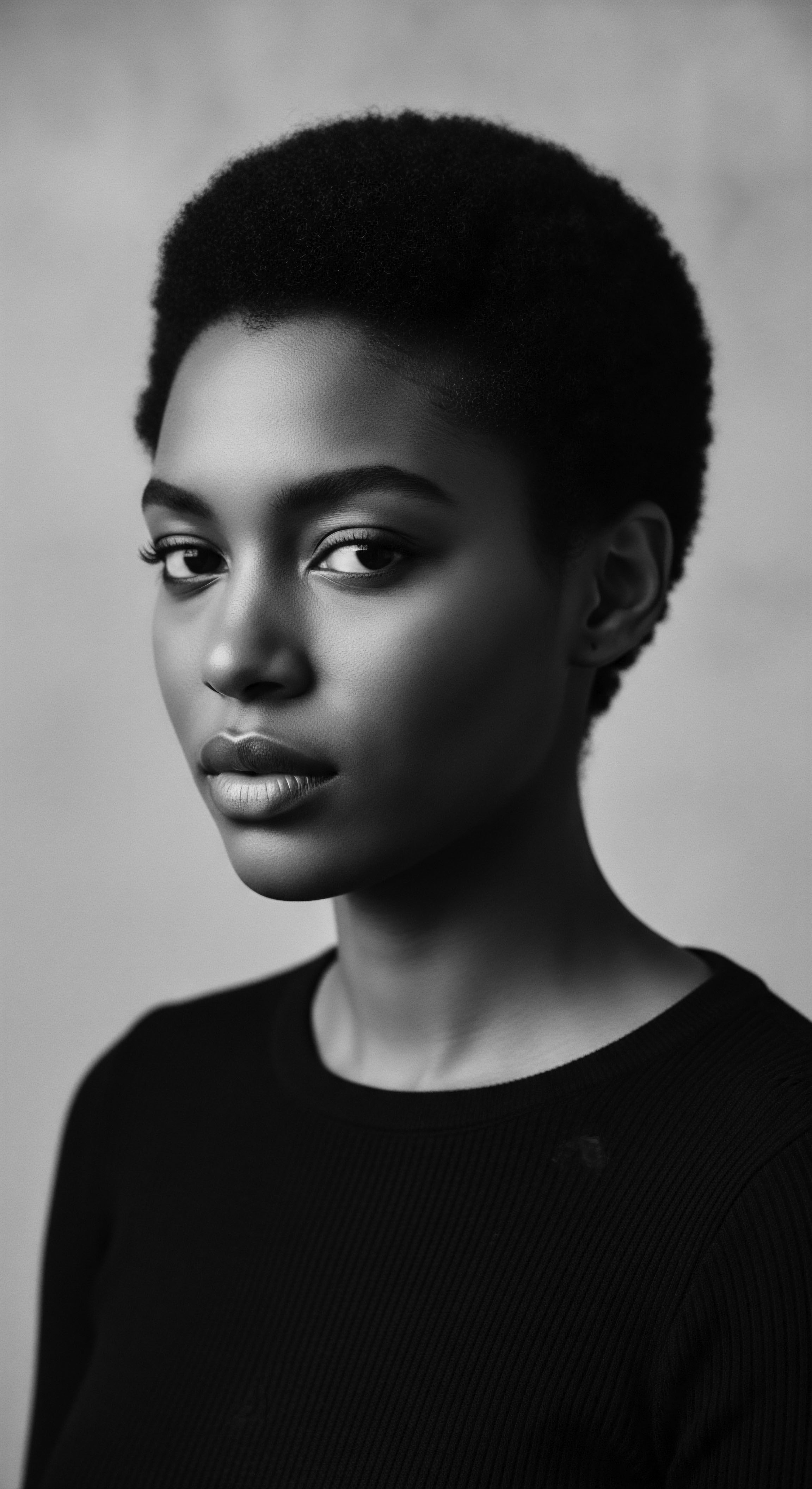
The Biophysical Substrate of Silent Narratives
The unique morphology of Afro-textured hair, characterized by its elliptical cross-section, tighter curl patterns, and fewer cuticle layers at the curves of the helix, contributes to its specific mechanical properties and susceptibility to certain forms of manipulation. These characteristics, while sometimes posing challenges for moisture retention or detangling, also afford textured hair a remarkable capacity for holding intricate styles, a quality historically leveraged for covert messaging. The inherent ‘memory’ of the curl pattern, its tendency to revert to its natural state, and its volumetric density allow for styles that are both visually complex and structurally stable, making them ideal for encoding information that needs to be preserved and transported.
Consider the science behind protective styles, such as cornrows or locs. These styles minimize manipulation of individual strands, reduce tangling, and help retain moisture, thereby promoting hair health. From an academic standpoint of Covert Communication, these practices also serve a dual function ❉ they are biologically sound hair care strategies, and simultaneously, they are cultural artifacts imbued with layers of meaning.
The tightness of a braid, the direction of a cornrow, or the specific sections used in locs could, in historical contexts, be interpreted as a deliberate encoding of information, understood only by those initiated into the specific cultural or resistive lexicon. The hair’s natural inclination to hold these forms makes it a reliable medium for such long-term, silent transmission.
A deeper understanding of the chemical composition of hair, particularly the disulfide bonds that contribute to its structural integrity, reveals how traditional practices, such as oiling with natural butters or clays, might have unknowingly reinforced the hair’s ability to serve as a communicative medium. While the primary intent was likely nourishment and protection, the physical manipulation and conditioning would have maintained the hair’s pliability and strength, essential for intricate styling that could convey messages. This intersection of ancestral knowledge and contemporary scientific understanding highlights the profound wisdom embedded in traditional hair care.

The Sociolinguistics of Hair ❉ Case Study of Colombian Palenques
One compelling historical example that powerfully illuminates the connection between Covert Communication and textured hair heritage lies in the practices of enslaved Africans in colonial Colombia. In the early 17th century, communities of escaped enslaved people, known as Maroons, established autonomous settlements called Palenques. The most renowned of these is Palenque de San Basilio, the first free village in the Americas of African heritage. Within these nascent communities, and during the perilous journeys to freedom, hair braiding transcended mere adornment; it became a sophisticated, life-saving system of communication.
Enslaved women, facing brutal restrictions on literacy and overt communication, ingeniously utilized cornrows to create tactile and visual maps of escape routes. These were not abstract symbols, but precise topographical representations. For example, specific cornrow patterns, such as the “departe” style, characterized by thick braids tied into buns on top of the head, were reportedly used to signal plans for escape. Other patterns mimicked the winding paths of rivers, the contours of mountains, or the layout of fields, providing literal guides to freedom.
This allowed for the clandestine dissemination of critical geographical intelligence among those planning to flee. The hair itself became a living cartographic document, carried on the heads of those who would become messengers of liberation.
Furthermore, these braided styles served as hidden repositories for vital provisions. Small quantities of rice grains or seeds were braided into the hair, providing sustenance for the arduous journeys to the Palenques. This practice, beyond its immediate practical utility, speaks to a profound level of foresight and communal care, where the very act of styling hair was an act of survival and collective planning.
The oral histories maintained by Afro-Colombian communities provide the primary evidence for these practices, as official histories, often told by colonial powers, deliberately suppressed such narratives of resistance. The absence of extensive archival documentation for such “covert” acts underscores the very nature of this communication ❉ it was designed to be unseen, unheard, and untraceable by oppressors, making oral tradition a crucial historical anchor.
The resilience of this communication system, rooted in ancestral African braiding techniques, allowed for the preservation of collective memory and the coordinated efforts necessary for establishing and sustaining free communities. This case study of the Colombian Palenques exemplifies how Covert Communication in textured hair was not simply a cultural expression, but a strategic, life-affirming tool for self-liberation and the establishment of new societal structures, affirming the hair’s deep meaning as a vessel of freedom.
- Topographical Encoding ❉ Cornrow patterns replicated geographical features, such as rivers, mountains, and pathways, serving as literal maps for escape.
- Provision Concealment ❉ Seeds, grains, or small amounts of gold were hidden within the braids to aid survival during journeys to freedom.
- Community Solidarity ❉ The communal act of braiding fostered trust and reinforced social bonds, ensuring the integrity of the covert messages.
- Cultural Continuity ❉ These practices preserved ancestral knowledge and resistance strategies, maintaining a link to African heritage despite forced displacement.
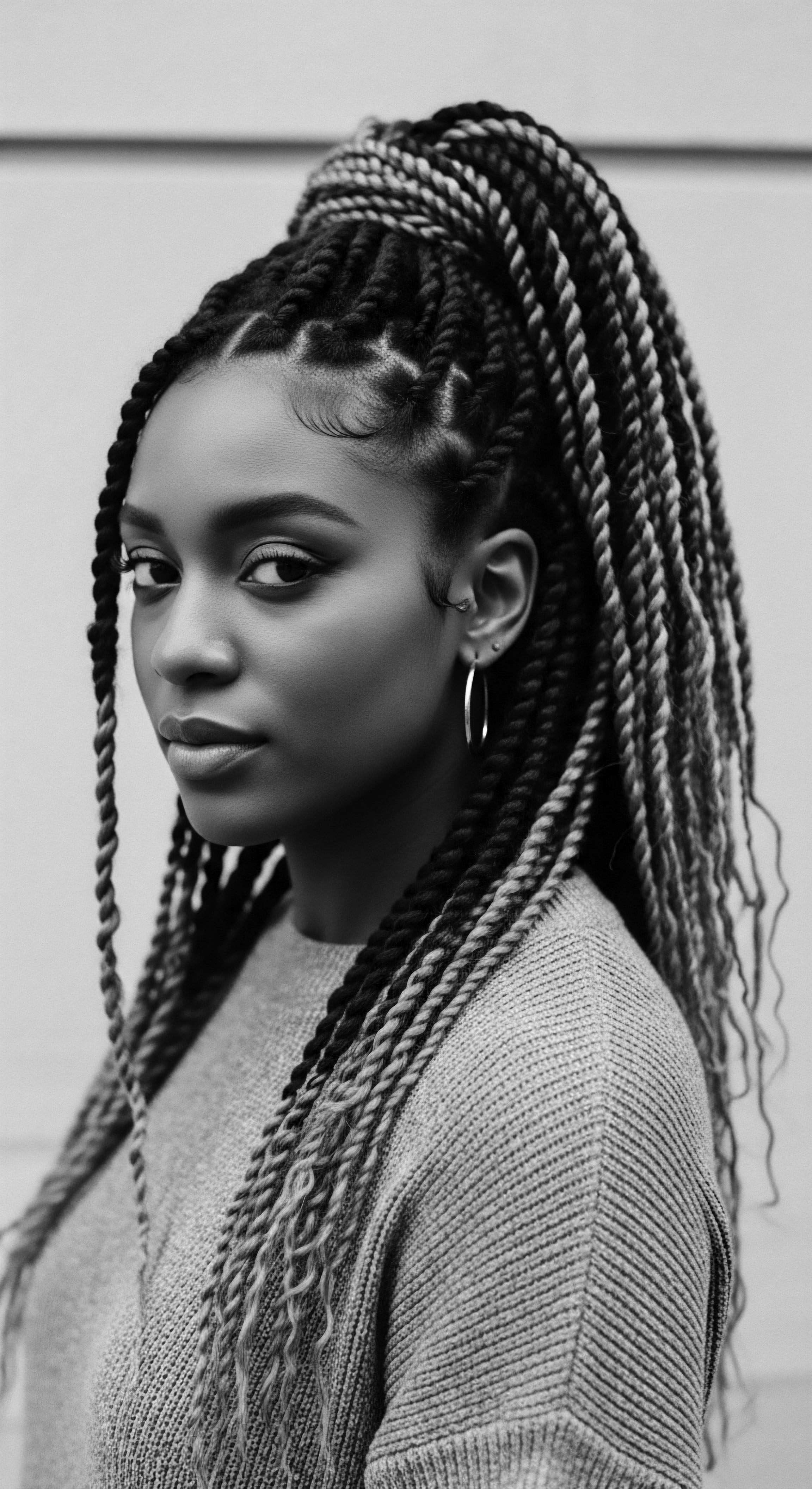
Interconnected Incidences ❉ Hair as a Psychosocial Marker
Beyond the overt acts of resistance, Covert Communication also extends to the psychosocial dimensions of textured hair. In societies where Eurocentric beauty standards were enforced, the very choice to wear natural or traditional textured hairstyles became a subtle yet powerful act of defiance and identity affirmation. Social and cultural psychologist Johanna Lukate points out that for women of color, hairstyling is often about managing a marginalized identity, navigating a world where they are judged not just by their actions but by physical attributes like hair texture. The choice of a particular style, therefore, communicates a stance on self-acceptance, cultural pride, and resistance to imposed norms.
The “pencil Test” in apartheid South Africa provides a stark example of how hair texture was weaponized for social control and classification. This discriminatory practice involved inserting a pencil into a person’s hair to determine their proximity to “whiteness” and, consequently, their access to political, social, and economic privileges. If the pencil held in the hair, it indicated a more tightly coiled texture, classifying the individual as “Black” or “Coloured” with fewer rights; if it fell out, it suggested a straighter texture, affording them more privileges. This insidious application of hair texture as a determinant of social standing underscores the deep societal meanings imposed upon textured hair, and how the very presence of a particular hair type could be a covert signal of one’s marginalized position.
However, even in the face of such oppressive systems, the inherent characteristics of textured hair became a site of resistance. The Afro, for instance, became a global symbol of Black pride and liberation during the Civil Rights and Black Power movements, communicating a powerful message of self-love and political solidarity. The refusal to chemically straighten hair, despite societal pressures, was a quiet yet profound act of Covert Communication, signaling a rejection of imposed beauty standards and an embrace of ancestral heritage. This ongoing dialogue between hair, identity, and societal perception reveals the enduring significance of Covert Communication in shaping individual and collective narratives.
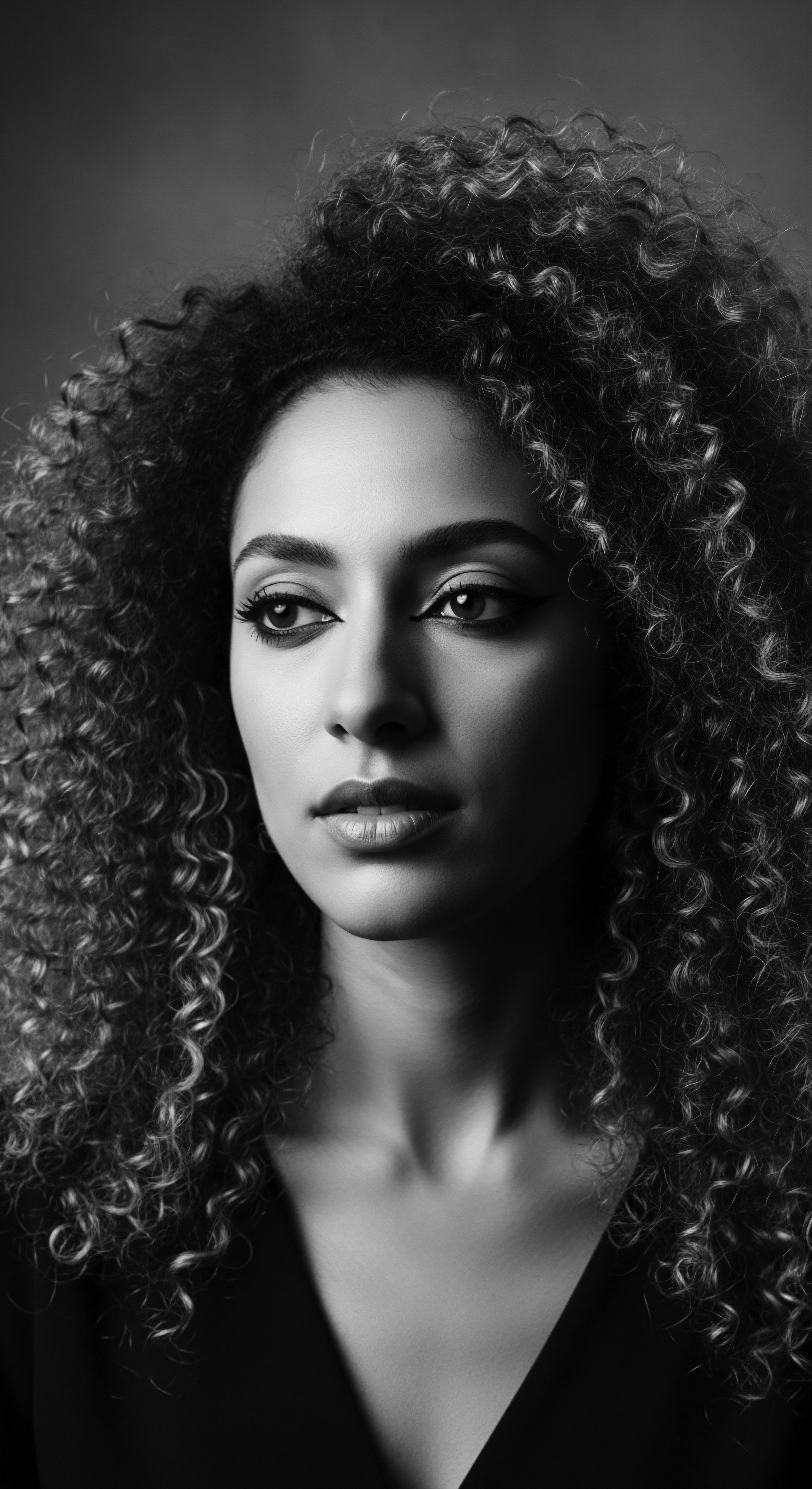
Reflection on the Heritage of Covert Communication
The journey through the definition of Covert Communication reveals a profound meditation on the enduring legacy of textured hair. It is a testament to the boundless ingenuity and spirit of Black and mixed-race communities, who, across centuries and continents, transformed their hair into a canvas for silent storytelling and resilient self-expression. From the earliest communal braiding circles in ancient Africa, where social standing and spiritual connections were articulated through intricate patterns, to the clandestine cornrow maps of enslaved ancestors navigating paths to freedom, hair has served as a consistent, living repository of cultural heritage. This unbroken lineage of silent dialogue, often born from necessity and oppression, continues to speak volumes in contemporary times, informing the choices of those who wear their natural textures with pride.
The wisdom held within each strand, the historical echoes in every coil, and the quiet declarations of identity in every style remind us that beauty is not merely skin deep; it is deeply rooted in ancestry and experience. The exploration of Covert Communication calls us to listen intently to these unspoken narratives, to honor the deep meanings that transcend words, and to recognize the hair on our heads as a powerful, living connection to those who came before us. This heritage is not static; it is a dynamic, evolving dialogue, continuously affirming the strength, creativity, and enduring spirit of a people. Understanding this silent language allows us to appreciate the profound value of textured hair, not just as a physical attribute, but as a sacred vessel of collective memory and an enduring symbol of resilience.

References
- Adetutu, O. (2018). The Significance of Hair in Ancient African Civilizations. Journal of Pan African Studies.
- Byrd, A. D. & Tharps, L. (2014). Hair Story ❉ Untangling the Roots of Black Hair in America. St. Martin’s Press.
- Dabiri, E. (2020). Don’t Touch My Hair. Harper Perennial.
- Gordon, M. (2009). Hair ❉ Public, Political, Extremely Personal. Bloomsbury Publishing.
- Heaton, S. (2021). Heavy is the Head ❉ Evolution of African Hair in America from the 17th c. to the 20th c. Library of Congress.
- Lakoff, G. & Johnson, M. (1999). Philosophy in the Flesh ❉ The Embodied Mind and Its Challenge to Western Thought. Basic Books.
- Lukate, J. (2018). The Psychology of Black Hair. TEDxCambridgeUniversity.
- Matshego, L. (2020). A History of African Women’s Hairstyles .
- Simon, D. (2009). Hair ❉ Public, Political, Extremely Personal. Bloomsbury Publishing.
- Tharps, L. (2021). Tangled Roots ❉ Decoding the History of Black Hair. CBC Radio.
